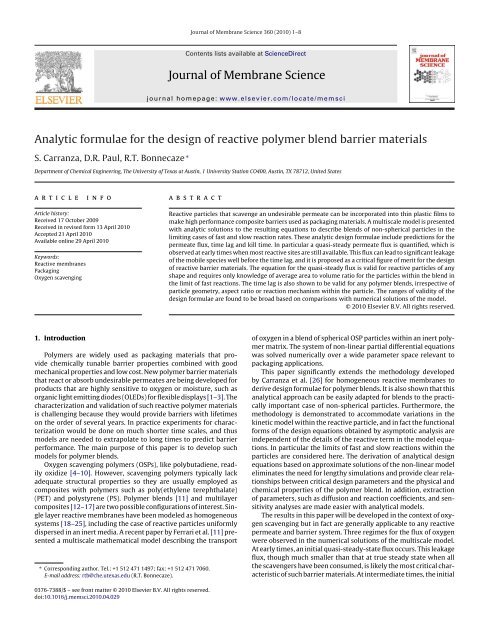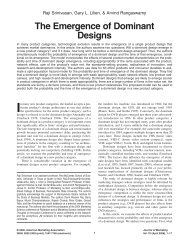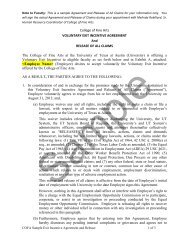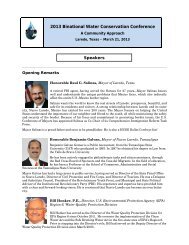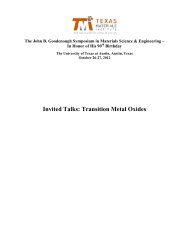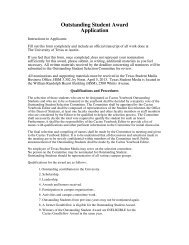Analytic design formulae for the design of reactive polymer blend ...
Analytic design formulae for the design of reactive polymer blend ...
Analytic design formulae for the design of reactive polymer blend ...
You also want an ePaper? Increase the reach of your titles
YUMPU automatically turns print PDFs into web optimized ePapers that Google loves.
Journal <strong>of</strong> Membrane Science 360 (2010) 1–8Contents lists available at ScienceDirectJournal <strong>of</strong> Membrane Sciencejournal homepage: www.elsevier.com/locate/memsci<strong>Analytic</strong> <strong><strong>for</strong>mulae</strong> <strong>for</strong> <strong>the</strong> <strong>design</strong> <strong>of</strong> <strong>reactive</strong> <strong>polymer</strong> <strong>blend</strong> barrier materialsS. Carranza, D.R. Paul, R.T. Bonnecaze ∗Department <strong>of</strong> Chemical Engineering, The University <strong>of</strong> Texas at Austin, 1 University Station CO400, Austin, TX 78712, United StatesarticleinfoabstractArticle history:Received 17 October 2009Received in revised <strong>for</strong>m 13 April 2010Accepted 21 April 2010Available online 29 April 2010Keywords:Reactive membranesPackagingOxygen scavengingReactive particles that scavenge an undesirable permeate can be incorporated into thin plastic films tomake high per<strong>for</strong>mance composite barriers used as packaging materials. A multiscale model is presentedwith analytic solutions to <strong>the</strong> resulting equations to describe <strong>blend</strong>s <strong>of</strong> non-spherical particles in <strong>the</strong>limiting cases <strong>of</strong> fast and slow reaction rates. These analytic <strong>design</strong> <strong><strong>for</strong>mulae</strong> include predictions <strong>for</strong> <strong>the</strong>permeate flux, time lag and kill time. In particular a quasi-steady permeate flux is quantified, which isobserved at early times when most <strong>reactive</strong> sites are still available. This flux can lead to significant leakage<strong>of</strong> <strong>the</strong> mobile species well be<strong>for</strong>e <strong>the</strong> time lag, and it is proposed as a critical figure <strong>of</strong> merit <strong>for</strong> <strong>the</strong> <strong>design</strong><strong>of</strong> <strong>reactive</strong> barrier materials. The equation <strong>for</strong> <strong>the</strong> quasi-steady flux is valid <strong>for</strong> <strong>reactive</strong> particles <strong>of</strong> anyshape and requires only knowledge <strong>of</strong> average area to volume ratio <strong>for</strong> <strong>the</strong> particles within <strong>the</strong> <strong>blend</strong> in<strong>the</strong> limit <strong>of</strong> fast reactions. The time lag is also shown to be valid <strong>for</strong> any <strong>polymer</strong> <strong>blend</strong>s, irrespective <strong>of</strong>particle geometry, aspect ratio or reaction mechanism within <strong>the</strong> particle. The ranges <strong>of</strong> validity <strong>of</strong> <strong>the</strong><strong>design</strong> <strong><strong>for</strong>mulae</strong> are found to be broad based on comparisons with numerical solutions <strong>of</strong> <strong>the</strong> model.© 2010 Elsevier B.V. All rights reserved.1. IntroductionPolymers are widely used as packaging materials that providechemically tunable barrier properties combined with goodmechanical properties and low cost. New <strong>polymer</strong> barrier materialsthat react or absorb undesirable permeates are being developed <strong>for</strong>products that are highly sensitive to oxygen or moisture, such asorganic light emitting diodes (OLEDs) <strong>for</strong> flexible displays [1–3]. Thecharacterization and validation <strong>of</strong> such <strong>reactive</strong> <strong>polymer</strong> materialsis challenging because <strong>the</strong>y would provide barriers with lifetimeson <strong>the</strong> order <strong>of</strong> several years. In practice experiments <strong>for</strong> characterizationwould be done on much shorter time scales, and thusmodels are needed to extrapolate to long times to predict barrierper<strong>for</strong>mance. The main purpose <strong>of</strong> this paper is to develop suchmodels <strong>for</strong> <strong>polymer</strong> <strong>blend</strong>s.Oxygen scavenging <strong>polymer</strong>s (OSPs), like polybutadiene, readilyoxidize [4–10]. However, scavenging <strong>polymer</strong>s typically lackadequate structural properties so <strong>the</strong>y are usually employed ascomposites with <strong>polymer</strong>s such as poly(ethylene terephthalate)(PET) and polystyrene (PS). Polymer <strong>blend</strong>s [11] and multilayercomposites [12–17] are two possible configurations <strong>of</strong> interest. Singlelayer <strong>reactive</strong> membranes have been modeled as homogeneoussystems [18–25], including <strong>the</strong> case <strong>of</strong> <strong>reactive</strong> particles uni<strong>for</strong>mlydispersed in an inert media. A recent paper by Ferrari et al. [11] presenteda multiscale ma<strong>the</strong>matical model describing <strong>the</strong> transport∗ Corresponding author. Tel.: +1 512 471 1497; fax: +1 512 471 7060.E-mail address: rtb@che.utexas.edu (R.T. Bonnecaze).<strong>of</strong> oxygen in a <strong>blend</strong> <strong>of</strong> spherical OSP particles within an inert <strong>polymer</strong>matrix. The system <strong>of</strong> non-linear partial differential equationswas solved numerically over a wide parameter space relevant topackaging applications.This paper significantly extends <strong>the</strong> methodology developedby Carranza et al. [26] <strong>for</strong> homogeneous <strong>reactive</strong> membranes toderive <strong>design</strong> <strong><strong>for</strong>mulae</strong> <strong>for</strong> <strong>polymer</strong> <strong>blend</strong>s. It is also shown that thisanalytical approach can be easily adapted <strong>for</strong> <strong>blend</strong>s to <strong>the</strong> practicallyimportant case <strong>of</strong> non-spherical particles. Fur<strong>the</strong>rmore, <strong>the</strong>methodology is demonstrated to accommodate variations in <strong>the</strong>kinetic model within <strong>the</strong> <strong>reactive</strong> particle, and in fact <strong>the</strong> functional<strong>for</strong>ms <strong>of</strong> <strong>the</strong> <strong>design</strong> equations obtained by asymptotic analysis areindependent <strong>of</strong> <strong>the</strong> details <strong>of</strong> <strong>the</strong> <strong>reactive</strong> term in <strong>the</strong> model equations.In particular <strong>the</strong> limits <strong>of</strong> fast and slow reactions within <strong>the</strong>particles are considered here. The derivation <strong>of</strong> analytical <strong>design</strong>equations based on approximate solutions <strong>of</strong> <strong>the</strong> non-linear modeleliminates <strong>the</strong> need <strong>for</strong> lengthy simulations and provide clear relationshipsbetween critical <strong>design</strong> parameters and <strong>the</strong> physical andchemical properties <strong>of</strong> <strong>the</strong> <strong>polymer</strong> <strong>blend</strong>. In addition, extraction<strong>of</strong> parameters, such as diffusion and reaction coefficients, and sensitivityanalyses are made easier with analytical models.The results in this paper will be developed in <strong>the</strong> context <strong>of</strong> oxygenscavenging but in fact are generally applicable to any <strong>reactive</strong>permeate and barrier system. Three regimes <strong>for</strong> <strong>the</strong> flux <strong>of</strong> oxygenwere observed in <strong>the</strong> numerical solutions <strong>of</strong> <strong>the</strong> multiscale model.At early times, an initial quasi-steady-state flux occurs. This leakageflux, though much smaller than that at true steady state when all<strong>the</strong> scavengers have been consumed, is likely <strong>the</strong> most critical characteristic<strong>of</strong> such barrier materials. At intermediate times, <strong>the</strong> initial0376-7388/$ – see front matter © 2010 Elsevier B.V. All rights reserved.doi:10.1016/j.memsci.2010.04.029
2 S. Carranza et al. / Journal <strong>of</strong> Membrane Science 360 (2010) 1–8Fig. 1. Schematic illustration <strong>of</strong> <strong>the</strong> <strong>polymer</strong> <strong>blend</strong> film and a particle in <strong>the</strong> limit <strong>of</strong> fast reaction.plateau gives way to a transient regime with increased oxygen flux,leading to <strong>the</strong> final regime, characterized by <strong>the</strong> time lag, when <strong>the</strong>flux approaches its steady-state value. <strong>Analytic</strong>al estimates <strong>for</strong> <strong>the</strong>initial flux plateau, <strong>for</strong> <strong>the</strong> intermediate transient flux, <strong>the</strong> time lagand kill time are presented along with <strong>the</strong>ir ranges <strong>of</strong> validity. Theextent and nature <strong>of</strong> <strong>the</strong> dependence <strong>of</strong> each regime on <strong>the</strong> particlegeometry and reactivity is discussed.2. Model descriptionConsider a membrane composed <strong>of</strong> <strong>reactive</strong> particles in an inert<strong>polymer</strong> matrix, as illustrated schematically in Fig. 1. The matrix istypically an inert <strong>polymer</strong> with good mechanical properties, suchas poly(ethylene terephthalate) (PET) or polystyrene (PS), while <strong>the</strong>particles are oxygen scavenging <strong>polymer</strong>s (OSPs) such as polybutadiene(PB). As <strong>the</strong> matrix is inert, <strong>the</strong> reaction is confined to <strong>the</strong>scavenging particles. The particles and <strong>the</strong> matrix are assumed initiallydevoid <strong>of</strong> oxygen. A transport model at <strong>the</strong> particle-scale isfirst developed and <strong>the</strong>n used to develop a multiscale transportmodel in a film <strong>of</strong> <strong>the</strong> <strong>blend</strong>.2.1. Particle modelThe <strong>reactive</strong> sites within each particle are immobilized and areconsumed as reaction progresses. Oxygen transport through <strong>the</strong>particle obeys Fick’s law. Initially, <strong>the</strong> particles are devoid <strong>of</strong> oxygenand all <strong>reactive</strong> sites are available. The material balances, initial andboundary conditions <strong>for</strong> oxygen and <strong>the</strong> <strong>reactive</strong> materials withina spherical particle, <strong>for</strong> example, are given by∂C p∂t= D p ∂r 2 ∂r(r 2 ∂C p∂r)− k R nC p , (1)∂n∂t =−ˆk R nC p , (2)I.C. : C p (r, t = 0) = 0, n(r, t = 0) = n 0 ,B.C. : ∂C p∂r∣∣r=0= 0, C p (r = R, t) = C mH , (3)where C p is <strong>the</strong> oxygen concentration within <strong>the</strong> OSP particle, t istime, r is <strong>the</strong> radial position in spherical coordinates, D p is <strong>the</strong> oxygendiffusion coefficient within <strong>the</strong> particle, k R is <strong>the</strong> bulk reactionrate constant <strong>for</strong> <strong>reactive</strong> particle, n is <strong>the</strong> concentration <strong>of</strong> <strong>reactive</strong>sites, ˆ is <strong>the</strong> stoichiometric constant relating moles <strong>of</strong> oxygen tomoles <strong>of</strong> <strong>reactive</strong> sites, R is <strong>the</strong> radius <strong>of</strong> <strong>the</strong> OSP particle, C m is <strong>the</strong>concentration <strong>of</strong> oxygen in <strong>the</strong> inert matrix, H = S m /S p is <strong>the</strong> partitioncoefficient relating <strong>the</strong> solubility <strong>of</strong> oxygen in <strong>the</strong> matrix S mto <strong>the</strong> solubility <strong>of</strong> oxygen oxidized OSP S p , and n 0 is initial concentration<strong>of</strong> <strong>reactive</strong> sites. We will now consider <strong>the</strong> limiting cases <strong>of</strong>very fast reaction and very slow reaction.2.1.1. Reaction is much faster than diffusionDo [27] has shown that <strong>for</strong> cases where reaction is muchfaster than diffusion within <strong>the</strong> particle, i.e., <strong>the</strong> Thiele modulus˚p = (R 2 k R n 0 /D p ) 1/2 ≫ 1, <strong>the</strong> shrinking core model is valid. In <strong>the</strong>shrinking core model <strong>the</strong> reaction progresses as a moving front,consuming <strong>the</strong> immobilized sites behind <strong>the</strong> front, and leaving anunreacted shrinking core ahead <strong>of</strong> <strong>the</strong> front. The pseudo-steadystateconcentration at <strong>the</strong> particle’s moving front and <strong>the</strong> rate <strong>of</strong>change <strong>of</strong> <strong>the</strong> core radius are thus given by [11]:C p (a) = C mH(1 + k pa 2D p R( Ra − 1 ) ) −1, (4)(∂a=−ˆk p C m1 + k pa 2 ( R) ) −1∂t n 0 H D p R a − 1 , (5)where C m is <strong>the</strong> oxygen concentration in <strong>the</strong> inert matrix, k p is aneffective surface rate constant, a is <strong>the</strong> radius <strong>of</strong> <strong>the</strong> <strong>reactive</strong> coreand R is <strong>the</strong> radius <strong>of</strong> <strong>the</strong> OSP particle. The effective surface √ rateconstant in <strong>the</strong> moving front regime is given by k p = D p k R n 0 ,as shown √ in [26]. Sample calculations <strong>of</strong> <strong>the</strong> <strong>reactive</strong> length scaleL rxn = D p /k R n 0 = D p /k p , covering <strong>the</strong> range <strong>of</strong> values used innumerical calculations <strong>of</strong> Ferrari et al. [11], are shown in Table 1(note that in [11] <strong>the</strong> Damköhler number <strong>for</strong> <strong>the</strong> OSP particle isdefined by Da OSP = Rk P /D p = ˚p). These indicate <strong>the</strong> validity <strong>of</strong> <strong>the</strong>shrinking core model <strong>for</strong> much <strong>of</strong> <strong>the</strong> practical range <strong>of</strong> physicalparameters. However, as it will be discussed in <strong>the</strong> next sections,<strong>the</strong> specific <strong>for</strong>m <strong>of</strong> Eq. (4) is only required <strong>for</strong> <strong>the</strong> derivation <strong>of</strong> <strong>the</strong>Table 1Sample calculations <strong>for</strong> OSP particles and <strong>blend</strong> <strong>for</strong> range <strong>of</strong> parameters used in [11].k p (cm/s) D p (cm 2 /s) R (m) L rxn (m) ˚p ˚bBase case 8 × 10 −5 2 × 10 −9 2.5 0.25 10 104Highest k p 1 × 10 −3 2 × 10 −9 2.5 0.02 125 367Low k p 1 × 10 −6 2 × 10 −9 2.5 20 0.1 12High D p 8 × 10 −5 2 × 10 −8 2.5 2.5 1 104Low D p 8 × 10 −5 2 × 10 −10 2.5 0.03 100 104High R 8 × 10 −5 2 × 10 −9 5.0 0.25 20 73Low R 8 × 10 −5 2 × 10√−9 0.5 0.25 2 231L rxn = D p/k p, ˚p = Rk P/D P, ˚b = 3k pL 2 /D mRH, where D m = 5.6 × 10 −9 cm 2 /s, H =1and L = 250 m <strong>for</strong> all cases above.
S. Carranza et al. / Journal <strong>of</strong> Membrane Science 360 (2010) 1–8 3Table 2Reactive sites material balance <strong>for</strong> various particle models. a .Shrinking core ˚p ≫ 1 Homogeneous ˚p ≪ 1Sphere = V 0/A 0k p, V 0/A 0 = R/3 = 1/k R n 0f (n/n 0) =∂n∂t , (11) ∂n(n/n 0 ) 2/3f (n/n 0) = n1+˚p((n/n 0 ) 1/3 −(n/n 0 ) 2/3 )n 0(n/n 0 ) 1/2f (n/n 0) = n1+˚p(n/n 0 ) 1/2 ln ((n/n 0 ) −1/2 )n 011+˚p(1−n/n 0 )√f (n/n 0) = nn 0R 2 k Rn 0/D p(n/n 0 ) 2/3, (6)1 + ˚p((n/n 0 ) 1/3 − (n/n 0 ) 2/3 )Cylinder = V 0/A 0k p, V 0/A 0 ∼ = R/2 = 1/kR n 0h 0 ≫ R f(n/n 0) =Disk = V 0/A 0k p, V 0/A 0 ∼ = h0/2 = 1/k R n 0h 0 ≪ R f(n/n 0) =√D p k Rn 0, ˚p = Rk p/D p =k p =aScavenger material balance is given by Eq. (12), ∂n =−ˆ C m∂t H f (n/n0).intermediate times regime, and variations <strong>of</strong> Eq. (4) can be easilyincluded in <strong>the</strong> model.Eq. (5) can be expressed in terms <strong>of</strong> <strong>the</strong> concentration <strong>of</strong> <strong>reactive</strong>sites n, which is proportional to <strong>the</strong> particle volume according to <strong>the</strong>relationship n/n 0 = V/V 0 = a 3 /R 3 , where n 0 is <strong>the</strong> initial concentration<strong>of</strong> <strong>reactive</strong> sites, V 0 is <strong>the</strong> initial scavenger particle volumeand V is <strong>the</strong> volume <strong>of</strong> <strong>the</strong> unreacted core. Thus, <strong>the</strong> scavenger siteconcentration equation and initial condition are given by∂n=−ˆk pAC p=−ˆ 3k p C m∂t V 0 R HI.C. : n(t = 0) = n 0 , (7)where A = 4a 2 is <strong>the</strong> particle surface area at <strong>the</strong> moving front,V 0 = 4R 3 /3 is <strong>the</strong> initial volume <strong>of</strong> <strong>the</strong> particle and ˚p = Rk P /D Pis <strong>the</strong> Thiele modulus <strong>for</strong> <strong>the</strong> particle, expressed in terms <strong>of</strong> <strong>the</strong>effective <strong>reactive</strong> rate constant k p . Equations similar to Eq. (6) canbe derived <strong>for</strong> shapes o<strong>the</strong>r than spheres and are listed in Table 2.2.1.2. Reaction is much slower than diffusionWhen reaction is much slower than diffusion, i.e., ˚p ≪ 1, <strong>the</strong>n<strong>the</strong> concentration is uni<strong>for</strong>m within <strong>the</strong> particle and <strong>the</strong> <strong>reactive</strong>sites are consumed uni<strong>for</strong>mly over time [28]. Eqs. (1) and (2) and<strong>the</strong> initial conditions reduce toC p = C mH , (8)∂n∂t =−ˆk C mR n, (9)HI.C. : n(t = 0) = n 0 . (10)2.2. Transport in <strong>the</strong> filmHere a model <strong>of</strong> <strong>the</strong> transport in <strong>the</strong> film <strong>of</strong> <strong>the</strong> <strong>blend</strong> is developedbased on <strong>the</strong> particle-scale reaction <strong>of</strong> oxygen with <strong>the</strong>scavengers. A schematic <strong>of</strong> <strong>the</strong> <strong>polymer</strong> <strong>blend</strong> <strong>of</strong> <strong>reactive</strong> particlesimbedded in an inert matrix is illustrated in Fig. 1. For packagingapplications <strong>the</strong> upstream side is exposed to an infinite source <strong>of</strong>oxygen at partial pressure (p O2 ) 0at time t = 0. This source is typicallyair and <strong>the</strong> downstream side has vanishing oxygen partial pressure.The oxygen concentration at <strong>the</strong> gas/<strong>polymer</strong> interface is assumedto obey Henry’s law. The particles are assumed to be uni<strong>for</strong>mly distributed,in large enough numbers and small enough compared to<strong>the</strong> film thickness that average effective properties can be used. Theconcentration pr<strong>of</strong>ile over <strong>the</strong> film takes into account <strong>the</strong> oxygenconsumption in each particle and <strong>the</strong> number density <strong>of</strong> particles in<strong>the</strong> film. The non-linear transport equations in <strong>the</strong> <strong>reactive</strong> <strong>blend</strong>,along with initial and boundary conditions, are given by∂C m∂t= D m∂ 2 C m∂x 2+ ˆ=−ˆ C m∂t H f (n/n 0), (12)I.C. : C m (x, t = 0) = 0, n(x, t = 0) = n 0 , (13)B.C. : C m (0) ≡ C m (x = 0,t) = S m p O2 ,C m (L) ≡ C m (x = L, t) = 0. (14)where D m is <strong>the</strong> oxygen diffusion coefficient <strong>of</strong> <strong>the</strong> inert matrix and is <strong>the</strong> volume fraction <strong>of</strong> OSP in <strong>polymer</strong> <strong>blend</strong>. The characteristictime and <strong>the</strong> generic function <strong>of</strong> <strong>reactive</strong> sites concentrationf (n/n 0 ) depend on <strong>the</strong> <strong>reactive</strong> model chosen <strong>for</strong> <strong>the</strong> particle. Forspherical particles in <strong>the</strong> limit <strong>of</strong> ˚p ≫ 1, = R/3k p and f (n/n 0 ) =(n/n 0 ) 2/3 /(1 + ˚p((n/n 0 ) 1/3 − (n/n 0 ) 2/3 )), recovering Eq. (6).In<strong>the</strong>limit <strong>of</strong> ˚p ≪ 1, = 1/k R n 0 and f (n/n 0 ) = n/n 0 , recovering Eq.(9). Expressions <strong>for</strong> and f (n/n 0 ) <strong>for</strong> <strong>the</strong> two different models <strong>of</strong>particle-scale and particle shapes are given in Table 2. Note thatEq. (12) is <strong>the</strong> generic <strong>for</strong>m <strong>of</strong> <strong>the</strong> material balance <strong>for</strong> <strong>reactive</strong>sites, which applies to both <strong>the</strong> homogeneous (slow reaction) andshrinking core (fast reaction) models <strong>of</strong> particles <strong>of</strong> any shape.The oxygen flux and <strong>the</strong> total amount <strong>of</strong> oxygen permeated arequantities <strong>of</strong> interest derived from <strong>the</strong> solution <strong>of</strong> Eqs. (11)–(14).The downstream flux J at time t is given by∣ J∣x=L =−D ∂Cm∂x ∣ , (15)x=Land <strong>the</strong> total oxygen permeated through <strong>the</strong> membrane Q t at timet is given by∫ tQ t = J| x=L dt. (16)0Numerical solutions <strong>of</strong> Eqs. (11)–(14) reveal three regimes <strong>of</strong>interest <strong>for</strong> <strong>the</strong> downstream flux (Fig. 2), as has been shown by Ferrariet al. [11]. The early time regime is characterized by a fast rise <strong>of</strong><strong>the</strong> flux, followed by a flux plateau. This quasi-steady plateau eventuallygives way to a second regime <strong>of</strong> rising oxygen flux. The thirdregime occurs when all <strong>the</strong> <strong>reactive</strong> sites have been consumed, and<strong>the</strong> flux reaches its final steady-state value. Note that <strong>the</strong> characteristictimes <strong>for</strong> each regime is independent <strong>of</strong> ˚p, as shown inFig. 2.The regimes observed in <strong>the</strong> transient downstream flux can bemapped to <strong>the</strong> concentration pr<strong>of</strong>iles, as illustrated in Fig. 3. Theearly time regime occurs be<strong>for</strong>e significant consumption <strong>of</strong> <strong>reactive</strong>sites. Most sites are still available, except <strong>for</strong> <strong>the</strong> region very closeto <strong>the</strong> upstream boundary. The uptake <strong>of</strong> oxygen in this regimecan be approximated by a simpler first-order reaction, as will bediscussed in <strong>the</strong> next section. For intermediate times, <strong>the</strong> concentrationpr<strong>of</strong>iles can be divided into three zones. The first zone ispredominantly diffusive, characterized by a linear oxygen concentrationpr<strong>of</strong>ile, with all <strong>the</strong> <strong>reactive</strong> sites consumed. The secondzone shows a non-linear decay in <strong>the</strong> oxygen concentration due toreaction, coupled with a gradual change in <strong>reactive</strong> sites concentration.In <strong>the</strong> third zone, most <strong>reactive</strong> sites are still available, and<strong>the</strong> oxygen concentration is vanishingly small, which is consistentwith <strong>the</strong> downstream boundary condition. A moving front developsduring this regime, leading to <strong>the</strong> analysis described in AppendixA to develop predictive equations <strong>for</strong> this regime. Note that thisis a front moving through <strong>the</strong> film and not to be confused with<strong>the</strong> moving front within <strong>the</strong> <strong>reactive</strong> particle illustrated in Fig. 1.Finally, <strong>the</strong> third regime occurs when all <strong>the</strong> <strong>reactive</strong> sites havebeen consumed, and <strong>the</strong> concentration pr<strong>of</strong>ile becomes linear over<strong>the</strong> whole film. This regime is characterized by <strong>the</strong> time lag, when<strong>the</strong> flux approaches its steady-state value.The three regimes illustrated in Figs. 2 and 3 are observed <strong>for</strong><strong>reactive</strong> transport in <strong>reactive</strong> <strong>polymer</strong> <strong>blend</strong>s as well as homogeneous<strong>reactive</strong> membranes. The analytical solutions <strong>for</strong> <strong>the</strong>se three
4 S. Carranza et al. / Journal <strong>of</strong> Membrane Science 360 (2010) 1–8Fig. 3. Concentration pr<strong>of</strong>iles <strong>for</strong> early, intermediate and long times.imated by <strong>the</strong> initial concentration <strong>of</strong> <strong>reactive</strong> sites n 0 . The oxygenflux in <strong>the</strong> plateau region <strong>of</strong> interest is also quasi-steady, and thus,<strong>the</strong> oxygen transport equation and boundary conditions becomeFig. 2. Comparison <strong>of</strong> numerical solution and analytical estimates <strong>for</strong> <strong>the</strong> threeregimes relevant to analysis <strong>of</strong> dimensionless downstream oxygen flux <strong>for</strong> = 0.0023, ˚b = 18 and (a) ˚p = 0.125, (b) ˚p = 1.25 and (c) ˚p = 12.5. Solutionsbased on shrinking core particle model (solid line = numerical solution, dashedline = prediction) and <strong>the</strong> bulk reaction particle model (dotted line = numerical solution,dash-dot = prediction) are compared. The initial flux plateau (horizontal dashedline) is <strong>the</strong> same <strong>for</strong> both models and matches closely <strong>the</strong> numerical solution. Insetshows <strong>the</strong> time lag as determined from <strong>the</strong> numerical solution, using <strong>the</strong> asymptoteas Q t→∞.regimes are derived <strong>for</strong> <strong>polymer</strong> <strong>blend</strong>s in <strong>the</strong> next sections, following<strong>the</strong> framework described in Carranza et al. [26]. Table 3summarizes <strong>the</strong> approximate times <strong>for</strong> each time region in terms<strong>of</strong> <strong>the</strong> physical parameters <strong>of</strong> <strong>polymer</strong> <strong>blend</strong>s <strong>for</strong> oxygen scavenging.Similar analysis could be extended to <strong>blend</strong>s targeting o<strong>the</strong>rspecies, e.g. water, by modifying <strong>the</strong> scavenging behavior accordingly.3. Analysis <strong>of</strong> early times to estimate initial leakage fluxplateauAt early times, most <strong>of</strong> <strong>the</strong> scavenger sites remain unreacted,except those very close to <strong>the</strong> upstream boundary, as illustrated inFig. 3. There<strong>for</strong>e, <strong>the</strong> concentration <strong>of</strong> <strong>reactive</strong> sites n can be approx-d 2 C mdx 2− C m= 0, (17) HB.C. : C m (0) C m (x = 0,t) = S m p O2 ,C m (L) C m (x = L, t) = 0. (18)Table 3<strong>Analytic</strong>al predictions <strong>of</strong> dimensionless flux <strong>for</strong> early, intermediate and long times<strong>for</strong> a <strong>reactive</strong> <strong>polymer</strong> <strong>blend</strong>.Time intervalEarly times aDimensional equationsJ| x=L = 2J SS˚b e −˚bt onset ≤ t ≤ t SFt onset = ((˚b − 1) H/2)√Intermediate times J| x=L = bJ SS (L/x F ) e −˚b (1−x F /L) , x F = 2 D m tt SF ≤ t ≤ t SF = H/2Long timesJ| x=L → J SS = C m(0)D m/Lt > √√= 0(1+3/)˚b = L 2 /D mH, ˚p = R 2 k R n 0/D p, = ˆC m(0)/n 0, 0 = L 2 /6D m. = 1/k R n 0 <strong>for</strong> ˚p ≪ 1, = V 0/A 0k p <strong>for</strong> ˚p ≫ 1.a J| x=L ∼ = 0 <strong>for</strong> t < tonset.
S. Carranza et al. / Journal <strong>of</strong> Membrane Science 360 (2010) 1–8 5Fig. 4. Parity chart <strong>for</strong> flux plateau comparing numerical solution and analytical prediction<strong>for</strong> various ˚b and ˚p. The values in paren<strong>the</strong>sis give ˚b and ˚p, respectively,<strong>for</strong> each data point.This equation, along with <strong>the</strong> boundary conditions can be easilysolved to show thatC m =−C m (0) cosh(˛L)sinh(˛L) sinh(˛x) + C m(0) cosh(˛x), (19)√where ˛ = /H. Using Eq. (15) <strong>for</strong> <strong>the</strong> downstream flux withEq. (19) <strong>for</strong> oxygen concentration gives <strong>the</strong> following expression<strong>for</strong> <strong>the</strong> flux:∣∣J∣x=L = ˛LJ SS/sinh(˛L), or J∣x=L ∼2˛LJ SSe −˛L <strong>for</strong> ˛L ≫ 1, (20)where J SS is <strong>the</strong> steady-state oxygen flux Flux SS = J SS = C m (0)D m /L.Solovyov and Goldman [24] derived a similar equation <strong>for</strong> <strong>the</strong> fluxto describe a system with a large excess <strong>of</strong> <strong>reactive</strong> sites, as part<strong>of</strong> <strong>the</strong>ir modified moving front model. Here this model is used todescribe <strong>the</strong> flux in <strong>the</strong> early time regime.This equation can be expressed in terms <strong>of</strong> <strong>the</strong> √effective Thielemodulus <strong>for</strong> <strong>the</strong> film <strong>of</strong> <strong>the</strong> <strong>polymer</strong> <strong>blend</strong> ˚b = L 2 /D m H, i.e.,<strong>the</strong> ratio <strong>of</strong> <strong>the</strong> length scale <strong>of</strong> diffusion through <strong>the</strong> film and <strong>the</strong>length scale <strong>of</strong> reaction within <strong>the</strong> particle so thatFlux plat = J| x=L = 2J SS˚b e −˚b , (21)which is valid <strong>for</strong> ˚b ≫ 1. This algebraic expression predicts <strong>the</strong>initial flux plateau using physical properties that can be measuredexperimentally. Note that in <strong>the</strong> limit <strong>of</strong> ˚p ≪ 1, = 1/k R n 0 asshown in Table 2, thus making Eq. (21) independent <strong>of</strong> particleshape or surface area. In <strong>the</strong> limit <strong>of</strong> ˚p ≫ 1, = V 0 /A 0 k p in generalagain√regardless <strong>of</strong> particle shape as shown in Table 2, and thus˚b = A 0 k p L 2 /V 0 D m H. There<strong>for</strong>e, <strong>the</strong> flux given by Eq. (21) isindependent <strong>of</strong> particle shape and depends only on <strong>the</strong> specific areaA 0 /V 0 in <strong>the</strong> limit <strong>of</strong> ˚p ≫ 1. In systems where particle shape cannotbe described by simple geometries, A 0 /V 0 can be determined byanalyzing images, e.g., by transmission electron microscopy, using<strong>the</strong> principles <strong>of</strong> stereology [29,30]. Eq. (21) is identical in functional<strong>for</strong>m in <strong>the</strong> limit <strong>of</strong> fast and slow reactions within <strong>the</strong> particles.Indeed <strong>the</strong> existence <strong>of</strong> <strong>the</strong> quasi-steady plateau flux is independent<strong>of</strong> <strong>the</strong> details <strong>of</strong> <strong>the</strong> reaction within <strong>the</strong> particle because atearly times all <strong>the</strong> scavenging sites are essentially accessible.The initial plateau estimate <strong>of</strong> Eq. (21) was compared to <strong>the</strong> valuesobtained by numerical solutions <strong>of</strong> <strong>the</strong> <strong>polymer</strong> <strong>blend</strong> modelequations and boundary conditions given by Eqs. (11)–(14) <strong>for</strong>both fast and slow reactions. The prediction is in excellent agreementwith <strong>the</strong> numerical solutions <strong>for</strong> all <strong>the</strong> cases computed,as illustrated in Fig. 2 and <strong>the</strong> parity√plot <strong>of</strong> Fig. 4. The plateauflux decreases with increasing ˚b = L 2 /D m H, as illustratedin Fig. 5. The plateau flux is proportional to <strong>the</strong> steady-state fluxJ SS = C m (0)D m /L, and consequently to <strong>the</strong> upstream oxygen con-Fig. 5. Dimensionless downstream oxygen flux <strong>for</strong> = 0.0023 and various ˚b and˚p. The values in paren<strong>the</strong>sis give ˚b and ˚p, respectively, <strong>for</strong> each case. The plateauflux increases with decreasing ˚b, as predicted by Eq. (21). The initial plateau regionis bound by <strong>the</strong> plateau onset t onset and t SF, as predicted by Eqs. (22) and (23).,respectively.centration C m (0). Increasing D m increases J SS and decreases ˚b,leading to an increase in <strong>the</strong> initial flux plateau. Conversely, increasingL decreases J SS and increases ˚b, leading to a decrease in <strong>the</strong>initial flux plateau. The increase in <strong>the</strong> flux due to increasing C m (0)or D m is expected, since <strong>the</strong> <strong>for</strong>mer causes more oxygen to be available,while <strong>the</strong> later enables fast transport <strong>of</strong> oxygen through <strong>the</strong>film, which leads to greater leakage through <strong>the</strong> film. Likewise, <strong>the</strong>decrease due to higher L is also expected, since <strong>for</strong> thicker films, <strong>the</strong>diffusion time is longer, allowing <strong>the</strong> reaction to occur and, thus,reducing <strong>the</strong> amount <strong>of</strong> oxygen breakthrough at early times.The onset <strong>of</strong> <strong>the</strong> initial plateau t onset can be derived by recognizingthat <strong>the</strong> transient can be modeled as an unsteady first-orderreaction diffusion problem. This t onset is <strong>the</strong> time lag <strong>for</strong> an equivalentfirst-order <strong>reactive</strong> membrane, given by [26]:t onset = ˚b coth(˚b) − 1, or t onset ∼ = ˚b − 12/H2/H <strong>for</strong> ˚b ≫ 1. (22)Note that <strong>the</strong> second approximate expression <strong>for</strong> <strong>the</strong> onset timeretains <strong>the</strong> constant 1 in <strong>the</strong> numerator because it is found to be agood approximation <strong>for</strong> ˚b as low as 2 or 3.The initial plateau regime eventually transitions to a fast rise in<strong>the</strong> downstream oxygen flux, in a transient regime described in <strong>the</strong>next section. The transition between <strong>the</strong>se two regimes occurs att SF , <strong>the</strong> time a steady front has been established. Following <strong>the</strong> stepsin [26], this time can be estimated by comparing <strong>the</strong> consumption<strong>of</strong> <strong>reactive</strong> sites within <strong>the</strong> front volume with <strong>the</strong> influx <strong>of</strong> oxygeninto <strong>the</strong> front volume, and is given byt SF = H2 , (23)where = ˆC m (0)/ n 0 is <strong>the</strong> ratio between dissolved oxygenand <strong>reactive</strong> capacity. When <strong>the</strong> onset <strong>of</strong> <strong>the</strong> initial plateaut onset = t SF (˚b − 1) occurs be<strong>for</strong>e <strong>the</strong> steady front has been established,i.e., 0
6 S. Carranza et al. / Journal <strong>of</strong> Membrane Science 360 (2010) 1–8Table 4Values <strong>of</strong> b in Eq. (26) <strong>for</strong> flux estimate <strong>for</strong> <strong>blend</strong>s <strong>of</strong> spherical particles with various˚p.˚p = (Rk P/D P) = (R 2 k Rn 0/D p) 1/2Homogeneous film 0.6530.1 0.5141 0.58110 1.54100 335tration equations are given by∂C m∂t= D m∂ 2 C m∂x 2− 3k pRC mH(n/n 0 ) 2/3, (24)1 + ˚p((n/n 0 ) 1/3 − (n/n 0 ) 2/3 )∂n∂t =−ˆ 3k p C m (n/n 0 ) 2/3. (25)R H 1 + ˚p((n/n 0 ) 1/3 − (n/n 0 ) 2/3 )Solutions in <strong>the</strong> frame <strong>of</strong> reference <strong>of</strong> <strong>the</strong> moving reaction zonewere developed, as shown in Appendix A, giving <strong>the</strong> algebraicexpression <strong>for</strong> <strong>the</strong> downstream flux:∣ J∣x=L = bJ L/x FSSe˚b (1−x F /L) , (26)where √ J SS = C m (0)D m /L is <strong>the</strong> steady-state oxygen flux andx F = 2 D m t is <strong>the</strong> position <strong>of</strong> <strong>the</strong> moving front. Values <strong>of</strong> bin Eq. (26), which are listed in Table 4 <strong>for</strong> spherical particles andvarious values <strong>of</strong> ˚p, are computed by numerical solutions <strong>of</strong> <strong>the</strong>moving front ODEs, as discussed in Appendix A. Note that <strong>the</strong>functional <strong>for</strong>m <strong>of</strong> Eq. (26) is valid <strong>for</strong> a wide range <strong>of</strong> models, withspecific values <strong>of</strong> b computed <strong>for</strong> each different model. In <strong>the</strong> limit<strong>of</strong> ˚p ≪ 1 <strong>the</strong> transient result <strong>for</strong> <strong>the</strong> homogenous film is recoveredwhere b = 0.653 [26]. Fig. 2 compares <strong>the</strong> numerical solution to <strong>the</strong>predicted values <strong>of</strong> <strong>the</strong> initial flux plateau [Eq. (21)] and <strong>the</strong> intermediatetransient flux [Eq. (26)] using <strong>the</strong> shrinking core particlemodel [Eqs. (24) and (25)] and <strong>the</strong> bulk reaction particle model[Eqs. (11) and (12) where = 1/k R n 0 and f (n/n 0 ) = n/n 0 ]. Thegraphs show <strong>the</strong> results <strong>for</strong> ˚p = 0.125, ˚p = 1.25 and ˚p = 12.5,where = 0.0023 and ˚b = 18 <strong>for</strong> all cases. Note that <strong>the</strong> results<strong>for</strong> <strong>the</strong> shrinking core particle model and <strong>the</strong> bulk reaction particlemodel are nearly identical <strong>for</strong> ˚p = 0.125 and ˚p = 1.25, <strong>the</strong>re<strong>for</strong>eboth models can be used in this range <strong>of</strong> ˚p.As indicated in Table 3, <strong>the</strong> transient flux prediction <strong>of</strong> Eq. (26)is valid between <strong>the</strong> time a steady front has been established [t SFgiven by Eq. (23)] to <strong>the</strong> time be<strong>for</strong>e <strong>the</strong> front has reached <strong>the</strong> rightboundary, i.e., when most <strong>of</strong> <strong>the</strong> <strong>reactive</strong> sites have been consumed.Note that <strong>for</strong> larger ˚p (Fig. 2c) <strong>the</strong> flux increase from <strong>the</strong> initialplateau flux starts be<strong>for</strong>e t SF , resulting in a larger deviation from<strong>the</strong> predicted values.5. Figures <strong>of</strong> meritThe prediction <strong>of</strong> time lag <strong>for</strong> a <strong>reactive</strong> <strong>polymer</strong> <strong>blend</strong> wasderived in Ferrari et al. [11], following a method developed by Frisch[31], and adapted by Siegel and Cussler [18] to estimate <strong>the</strong> timelag <strong>for</strong> homogeneous <strong>reactive</strong> membranes. The expression derivedby Ferrari et al. is given by = 0 (1 + 3/), (27)where 0 = L 2 /6D m is <strong>the</strong> diffusion time lag <strong>of</strong> <strong>the</strong> inert matrix and = ˆC m (0)/n 0 is <strong>the</strong> ratio between dissolved oxygen and <strong>reactive</strong>capacity. This algebraic equation <strong>for</strong> time lag was obtained assumingspherical particles, but is in fact generally valid irrespective <strong>of</strong><strong>the</strong> shapes or sizes <strong>of</strong> <strong>the</strong> particles, and irrespective <strong>of</strong> <strong>the</strong> specificreaction mechanism within <strong>the</strong> particles. Note that <strong>the</strong> time lagbdepends only on <strong>the</strong> diffusion time scale through <strong>the</strong> inert matrix,and <strong>the</strong> ratio between dissolved oxygen and scavenging capacity <strong>of</strong><strong>the</strong> <strong>blend</strong>.The cumulative oxygen permeate Q t is obtained by <strong>the</strong> integration<strong>of</strong> <strong>the</strong> downstream flux, per Eq. (16), and can be estimatedanalytically by adding <strong>the</strong> contributions from <strong>the</strong> initial plateauregime, see Eq. (21), and <strong>the</strong> transient regime, see Eq. (26). Thus,<strong>the</strong> oxygen permeate can be estimated byQ t =∫ tSFt onset= 2J SSt SF ˚be˚b∫ tJ∣dt + x=Lt SF∣J∣x=L dt(1 + (1 − ˚b) + b (e√ t/tSF− e)) . (28)For times below t SF , <strong>the</strong> above equation reduces to <strong>the</strong> first integral,2J SS˚be −˚b (t + t SF (1 − ˚b)), which is <strong>the</strong> initial flux plateaumultiplied by t − t onset . The kill time t K , i.e., <strong>the</strong> time when <strong>the</strong>oxygen permeate reaches a predefined max Q max , proposed as atransient parameter in [22], can be found by solving Eq. (28) <strong>for</strong>time, giving[t k = t SF ln 2 Qmax]e˚b 1 + (1 − ˚b)− + e . (29)2bJ SS t SF ˚b b6. Summary and conclusionsThe transport equations <strong>for</strong> a mobile permeate in a <strong>blend</strong> <strong>of</strong><strong>reactive</strong> particles in an inert matrix have been derived to describe<strong>reactive</strong> particles <strong>of</strong> any shape in <strong>the</strong> limits <strong>of</strong> fast reaction andslow reaction. The framework developed to derive analytical <strong>design</strong><strong><strong>for</strong>mulae</strong> <strong>for</strong> homogeneous <strong>reactive</strong> membranes [26] has beenextended to <strong>the</strong>se <strong>reactive</strong> <strong>polymer</strong> <strong>blend</strong>s, illustrating how <strong>the</strong>approach can be adapted <strong>for</strong> models with very distinct <strong>reactive</strong>terms. Equations <strong>for</strong> flux and characteristic times <strong>for</strong> <strong>the</strong> threeregimes identified in <strong>the</strong> numerical solutions have been derived<strong>for</strong> <strong>the</strong> <strong>polymer</strong> <strong>blend</strong>. It was found that <strong>the</strong> details <strong>of</strong> <strong>the</strong> reactionmechanism within <strong>the</strong> particles do not affect <strong>the</strong> functional<strong>for</strong>m <strong>of</strong> <strong>the</strong> analytic models and only affect <strong>the</strong> values <strong>of</strong> known oreasily determined constants in <strong>the</strong> predictive equations. The techniquepresented is broadly applicable and can be easily adapted toaccommodate o<strong>the</strong>r particle-scale reaction models.For <strong>the</strong> initial regime, when most <strong>reactive</strong> particles are still available,<strong>the</strong> initial plateau flux and plateau onset time t onset can bedetermined without knowledge <strong>of</strong> particle shapes, using instead<strong>the</strong> average area to volume ratio <strong>of</strong> <strong>the</strong> <strong>reactive</strong> particles A 0 /V 0 ,which can be determined by analyzing images using <strong>the</strong> principles<strong>of</strong> stereology. Likewise, <strong>the</strong> characteristic time <strong>for</strong> <strong>the</strong> intermediateregime t SF , which marks <strong>the</strong> end <strong>of</strong> <strong>the</strong> initial flux plateau,requires only knowledge <strong>of</strong> A 0 /V 0 . One <strong>of</strong> <strong>the</strong> critical conclusions<strong>of</strong> this paper is <strong>the</strong> generality <strong>of</strong> Eq. (21) <strong>for</strong> <strong>the</strong> prediction <strong>of</strong> thisflux. For many packaging applications, <strong>the</strong> initial plateau flux is <strong>the</strong>important <strong>design</strong> consideration because it characterizes <strong>the</strong> smallbut persistent leakage <strong>of</strong> oxygen through <strong>the</strong> barrier. Fur<strong>the</strong>rmore,<strong>the</strong> calculations <strong>for</strong> early times do not require <strong>the</strong> knowledge <strong>of</strong><strong>the</strong> reaction details within <strong>the</strong> particle. The value <strong>of</strong> <strong>the</strong> downstreamflux <strong>for</strong> intermediate times can be predicted analyticallyif <strong>the</strong> particle shape is known. The third regime, when most particleshave been consumed, is characterized by <strong>the</strong> time lag and<strong>the</strong> steady-state flux, which are completely independent <strong>of</strong> particleshape, area to volume ratios, or details <strong>of</strong> reaction within eachparticle.Traditionally, <strong>the</strong> time lag, which is independent <strong>of</strong> reaction rate,has been considered <strong>the</strong> figure <strong>of</strong> merit when <strong>design</strong>ing <strong>reactive</strong>membranes, as it marks <strong>the</strong> exhaustion <strong>of</strong> <strong>the</strong> <strong>reactive</strong> particles.However, this study suggests that <strong>the</strong> value <strong>of</strong> <strong>the</strong> initial fluxplateau, which accounts <strong>for</strong> both diffusion and reaction rates, along
S. Carranza et al. / Journal <strong>of</strong> Membrane Science 360 (2010) 1–8 7with its end time t SF are additional parameters to consider when<strong>design</strong>ing packaging materials. For applications where it may bepreferable to <strong>design</strong> a barrier which will remain in <strong>the</strong> plateauregion throughout <strong>the</strong> life <strong>of</strong> <strong>the</strong> product, <strong>the</strong> end <strong>of</strong> <strong>the</strong> usefullife may be determined by <strong>the</strong> beginning <strong>of</strong> <strong>the</strong> transient regiont SF instead <strong>of</strong> time lag , and <strong>the</strong> value <strong>of</strong> <strong>the</strong> flux plateau can beused to determine <strong>the</strong> total permeate over <strong>the</strong> life <strong>of</strong> <strong>the</strong> product.AcknowledgmentThis work was supported in part by <strong>the</strong> National Science Foundationunder Grant Number DMR0423914.Appendix A.Following Carranza et al. [26], solutions in <strong>the</strong> frame <strong>of</strong> reference<strong>of</strong> <strong>the</strong> moving reaction zone were developed, with solutions <strong>of</strong> <strong>the</strong><strong>for</strong>m:n(x, t)= (), (A.1)n 0C(x, t) = C m (0) =√Ht G(),(A.2)x − x F (t)√ , (A.3)D m H/where () represents <strong>the</strong> <strong>reactive</strong> site in <strong>the</strong> new frame <strong>of</strong> reference,G() is <strong>the</strong> self-similar oxygen √concentration field, H/ is <strong>the</strong><strong>reactive</strong> time scale <strong>for</strong> <strong>the</strong> <strong>blend</strong>, D m H/ is <strong>the</strong> <strong>reactive</strong> lengthscale <strong>for</strong> <strong>the</strong> <strong>blend</strong>. The position <strong>of</strong> <strong>the</strong> moving front is given by√x F = 2 D m t, (A.4)where = ˆC m (0) / n 0 is <strong>the</strong> ratio between dissolved oxygen and<strong>reactive</strong> capacity. The leading order equations <strong>for</strong> <strong>the</strong> <strong>polymer</strong><strong>blend</strong> becomed 2 Ĝ− Ĝf() = 0,d2 (A.5)d− Ĝf() = 0,d (A.6)B.C. : (∞) = 1, Ĝ(∞) = 0,dĜd ∣ =−1,−∞(A.7)where Ĝ = √ 2G.Provided that f () → 1as →∞, <strong>the</strong> asymptotic solutions <strong>of</strong><strong>the</strong>se equations as →∞are given byĜ = be − , = 1 − be − . (A.8)Thus, substituting Eq. (A.8) in Eq. (A.2) <strong>for</strong> concentration in <strong>the</strong>moving front regime and using Eq. (15) <strong>for</strong> flux gives Eq. (26), <strong>the</strong>algebraic expression <strong>for</strong> <strong>the</strong> downstream flux. Note that Eq. (26)functional <strong>for</strong>m is valid <strong>for</strong> any model with <strong>the</strong> asymptote f () → 1as →∞, regardless <strong>of</strong> <strong>the</strong> details <strong>of</strong> f (). If f () is known, <strong>the</strong>values <strong>of</strong> b may be computed by solving Eqs. (A.5) and (A.6) by<strong>the</strong> shooting method using Eq. (A.8) as <strong>the</strong> initial conditions whilevarying b until <strong>the</strong> condition <strong>for</strong> matching <strong>the</strong> asymptotic solutions<strong>of</strong> <strong>the</strong> diffusion zone and <strong>the</strong> moving reaction zone is satisfied, i.e.,Ĝ() =− as →−∞[26].Nomenclaturea radius <strong>of</strong> <strong>the</strong> <strong>reactive</strong> core, cmA area <strong>of</strong> scavenging core, cm 2A 0 area <strong>of</strong> scavenging particle, cm 2b constant <strong>for</strong> moving front flux prediction, dimensionlessC m O 2 concentration in <strong>the</strong> film, mol O2 /cm 3C m (0) oxygen concentration at <strong>the</strong> <strong>polymer</strong> <strong>blend</strong> filmupstream surface C m (0) = p O2 S m ,mol O2 /cm 3C p oxygen concentration in <strong>the</strong> OSP particle,mol O2 /cm 3 OSPD m oxygen diffusion coefficient <strong>of</strong> <strong>the</strong> inert matrix,cm 2 /sD p oxygen diffusion coefficient <strong>for</strong> <strong>the</strong> oxidized OSP,cm 2 /sf(n/n 0 ) <strong>reactive</strong> sites consumption function <strong>for</strong> a particleG variable <strong>for</strong> moving front analysis, dimensionlessĜ = √ 2GH partition coefficient, H = S m /S pJ oxygen flux, mol/cm 2 sk p reaction rate constant <strong>for</strong> <strong>reactive</strong> particle, cm/sk R bulk reaction rate constant <strong>for</strong> <strong>reactive</strong> particle,cm 3 OSP/mol RS sL thickness <strong>of</strong> <strong>the</strong> film, cmn concentration <strong>of</strong> <strong>reactive</strong> sites, mol RS /cm 3n 0 initial concentration <strong>of</strong> <strong>reactive</strong> sites, mol RS /cm 3p O2 oxygen partial pressure, MPaQ t oxygen permeate, mol/cm 2R radius <strong>of</strong> <strong>the</strong> OSP particle, cmS m solubility coefficient <strong>for</strong> oxygen in inert matrix,cm 3 (STP)/cm 3 MPaS p solubility coefficient <strong>for</strong> oxygen in <strong>the</strong> scavenging<strong>polymer</strong>, cm 3 (STP)/cm 3 MPat time, st K kill time, st onset onset time <strong>for</strong> <strong>the</strong> initial flux plateau, st SF time when a steady moving front is established, sV volume <strong>of</strong> <strong>reactive</strong> core, cm 3V 0 volume <strong>of</strong> scavenging particle, cm 3x position along film thickness, cmx F moving front position, cmẋ F moving front speed, cm/s∼ denotes dimensionless variablesGreek lettersˇ OSP capacity, ˇ = n 0 /ˆ, mol O2 /cm 3 OSP time lag, s 0 diffusion time lag <strong>of</strong> inert <strong>polymer</strong>, 0 = L 2 /6D m ,s volume fraction <strong>of</strong> OSP in <strong>polymer</strong> <strong>blend</strong>˚b effective √ Thiele modulus <strong>for</strong> <strong>the</strong> <strong>blend</strong>,˚b = L 2 /D m H˚p Thiele√modulus <strong>for</strong> <strong>the</strong> OSP particle,˚p = R 2 k R n 0 /D p or ˚p = Rk p /D p <strong>reactive</strong> sites expressed in terms <strong>of</strong> moving frontcoordinate ratio between dissolved oxygen and <strong>reactive</strong> capacity, = ˆC m (0)/n 0ˆ stoichiometric coefficient, mol RS mol O2 time scale, = V 0 /A 0 k p or = 1/k R n 0 ,s moving front coordinate, dimensionless
8 S. Carranza et al. / Journal <strong>of</strong> Membrane Science 360 (2010) 1–8References[1] P.E. Burrows, et al., Gas permeation and lifetime tests on <strong>polymer</strong>-based barriercoatings, Proc. SPIE 4105 (2001) 75–83.[2] J. Lewis, Material challenge <strong>for</strong> flexible organic devices, Mater. Today 9 (2006)38–45.[3] M.C. Choi, Y. Kim, C.S. Ha, Polymers <strong>for</strong> flexible displays: from material selectionto device applications, Prog. Polym. Sci. 33 (2008) 581–630.[4] A.V. Tobolsky, D.J. Metz, R.B. Mesrobian, Low temperature autoxidation <strong>of</strong>hydrocarbons: <strong>the</strong> phenomenon <strong>of</strong> maximum rates, J. Am. Chem. Soc. 72 (1950)1942–1952.[5] R.G. Bauman, S.H. Maron, Oxidation <strong>of</strong> polybutadiene. I. Rate <strong>of</strong> oxidation, J.Polym. Sci. 22 (1956) 1–12.[6] S.W. Beavan, D. Phillips, Mechanistic studies on <strong>the</strong> photo-oxidation <strong>of</strong> commercialpoly(butadiene), Eur. Polym. J. 10 (1974) 593–603.[7] J.F. Rabek, J. Lucki, B. Rånby, Comparative studies <strong>of</strong> reactions <strong>of</strong> commercial<strong>polymer</strong>s with molecular oxygen, singlet oxygen, atomic oxygen and ozone-I,Eur. Polym. J. 15 (1979) 1089–1100.[8] V.B. Ivanov, S.G. Burkova, Y.L. Morozov, V.Y. Shlyapintokh, Kinetics <strong>of</strong> <strong>the</strong>chain-propagation and chain-termination reactions in <strong>the</strong> oxidation <strong>of</strong> polybutadieneand co<strong>polymer</strong>s <strong>of</strong> butadiene with styrene, Kinet. Katal. 20/5 (1979)1330–1333.[9] C. Adam, J. Lacoste, J. Lemaire, Photo-oxidation <strong>of</strong> elastomeric materials. Part 1-Photo-oxidation <strong>of</strong> polybutadienes, Polym. Degrad. Stabil. 24 (1989) 185–200.[10] M. Piton, A. Rivaton, Photooxidation <strong>of</strong> polybutadiene at long wavelengths( > 300 nm), Polym. Degrad. Stabil. 53 (1996) 343–359.[11] M.C. Ferrari, S. Carranza, R.T. Bonnecaze, K.K. Tung, B.D. Freeman, D.R. Paul,Modeling <strong>of</strong> oxygen scavenging <strong>for</strong> improved barrier behavior: <strong>blend</strong> films, J.Membr. Sci. 329 (2009) 183–192.[12] C.D. Mueller, S. Nazarenko, T. Ebeling, T.L. Schuman, A. Hiltner, E. Baer, Novelstructures by microlayer coextrusion—Talc-filled PP, PC/SAN, and HDPE/LLDPE,Polym. Eng. Sci. 37/2 (1997) 355–362.[13] E.E. Nuxoll, E.L. Cussler, Layered <strong>reactive</strong> barrier films, J. Membr. Sci. 252 (2005)29–36.[14] S.E. Solovyov, A.Y. Goldman, Optimized <strong>design</strong> <strong>of</strong> multilayer barrier films incorporatinga <strong>reactive</strong> layer. I. Methodology <strong>of</strong> ingress analysis, J. Appl. Polym. Sci.100 (2006) 1940–1951.[15] S.E. Solovyov, A.Y. Goldman, Optimized <strong>design</strong> <strong>of</strong> multilayer barrier films incorporatinga <strong>reactive</strong> layer. II. Solute dynamics in two-layer films, J. Appl. Polym.Sci. 100 (2006) 1952–1965.[16] S.E. Solovyov, A.Y. Goldman, Optimized <strong>design</strong> <strong>of</strong> multilayer barrier films incorporatinga <strong>reactive</strong> layer. III. Case analysis and generalized multilayer solutions,J. Appl. Polym. Sci. 100 (2006) 1966–1977.[17] S.E. Solovyov, A.Y. Goldman, Mass Transport Reactive Barriers in Packaging,DEStech Publications, Lancaster, PA, 2008.[18] R.A. Siegel, E.L. Cussler, Reactive barrier membranes: some <strong>the</strong>oretical observationsregarding <strong>the</strong> time lag and breakthrough curves, J. Membr. Sci. 229 (2004)33–41.[19] C. Yang, E.E. Nuxoll, E.L. Cussler, Reactive barrier films, AIChE J. 47/2 (2001)295–302.[20] C. Yang, E.L. Cussler, Oxygen barriers that use free radical chemistry, AIChE J.47/12 (2001) 2725–2732.[21] N.K. Lape, C. Yang, E.L. Cussler, Flake-filled <strong>reactive</strong> membranes, J. Membr. Sci.209 (2002) 271–282.[22] E.E. Nuxoll, E.L. Cussler, The third parameter in <strong>reactive</strong> barrier films, AIChE J.51/2 (2005) 456–463.[23] S.E. Solovyov, A.Y. Goldman, Theory <strong>of</strong> transient permeation through <strong>reactive</strong>barrier films. I. Steady state <strong>the</strong>ory <strong>for</strong> homogeneous passive and <strong>reactive</strong>media, Int. J. Polym. Mater. 54 (2005) 71–91.[24] S.E. Solovyov, A.Y. Goldman, Theory <strong>of</strong> transient permeation through <strong>reactive</strong>barrier films. II. Two layer <strong>reactive</strong>-passive structures with dynamic interface,Int. J. Polym. Mater. 54 (2005) 93–115.[25] S.E. Solovyov, A.Y. Goldman, Theory <strong>of</strong> transient permeation through <strong>reactive</strong>barrier films. III. Solute ingress dynamics and model lag times, Int. J. Polym.Mater. 54 (2005) 117–139.[26] S. Carranza, D.R. Paul, R.T. Bonnecaze, Design <strong><strong>for</strong>mulae</strong> <strong>for</strong> <strong>reactive</strong> barriermembranes, Chem. Eng. Sci. 65 (2010) 1151–1158.[27] D.D. Do, On <strong>the</strong> validity <strong>of</strong> <strong>the</strong> shrinking core model in noncatalytic gas solidreaction, Chem. Eng. Sci. 37/10 (1982) 1477–1481.[28] O. Levenspiel, Chemical Reaction Engineering, 3rd ed., John Wiley & Sons, NewYork, 1999.[29] G. Thomas, M.J. Goringe, Transmission Electron Microscopy <strong>of</strong> Materials, Wiley,New York, 1979.[30] J.C. Russ, R.T. Deh<strong>of</strong>f, Practical Stereology, 2nd ed., Kluwer Academic/PlenumPublishers, New York, 2000.[31] H.L. Frisch, The time lag in diffusion, J. Phys. Chem. 61 (1957) 93–95.


